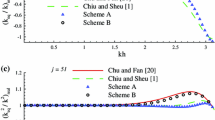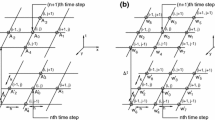Abstract
A new high spectral accuracy compact difference scheme is proposed here. This has been obtained by constrained optimization of error in spectral space for discretizing first derivative for problems with non-periodic boundary condition. This produces a scheme with the highest spectral accuracy among all known compact schemes, although this is formally only second-order accurate. Solution of Navier-Stokes equation for incompressible flows are reported here using this scheme to solve two fluid flow instability problems that are difficult to solve using explicit schemes. The first problem investigates the effect of wind-shear past bluff-body and the second problem involves predicting a vortex-induced instability.
Similar content being viewed by others
REFERENCES
Adams, N. A., and Shariff, K. (1996). A high resolution hybrid compact-ENO scheme for shock-turbulence interaction problems. J. Comp. Phys. 127, 27-51.
Box, G. E. P., and Draper, N. R. (1969). Evolutionary Operation, Wiley, New York.
Gustafsson, B., Kreiss, H. O., and Sundstrom, A. (1972). Stability theory for difference approximations of mixed initial boundary value problems, II. Math. Comp. 26, 649-686.
Haras, Z., and Ta'asan, S. (1994). Finite difference schemes for long-time integration. J. Comp. Phys. 114, 265-279.
Jordan, S. K., and Fromm, J. E. (1972). Laminar flow past a circle in a shear flow. Phys. Fluids, 15(6), 972-976.
Kawamura, T., Takami, H., and Kuwahara, K. (1985). A new higher order upwind scheme for incompressible Navier-Stokes equation. Fluid Dyn. Res. 1, 145-162.
Kiya, M., Tamura, H. and Arie, M. (1980). Vortex shedding from a circular cylinder in moderate-Reynolds number shear flow. J. Fluid Mech. 141(4), 721-735.
Lele, S. K. (1992). Compact finite difference schemes with spectral like resolution. J. Comp. Phys. 103, 16-42.
Nair, M. T., and Sengupta, T. K. (1997). Unsteady flow past elliptic cylinders. J. Fluids Struct. 11, 555-595.
Peridier, V. J., Smith, F. T., and Walker, J. D. A. (1991). Vortex-induced boundary-layer separation. Part 2. Unsteady interacting boundary-layer theory. J. Fluid Mech. 232, 133-165.
Sengupta, T. K., De, S., and Sarkar, S. (2003). Vortex-induced instability of incompressible wall-bounded shear layer. J. Fluid Mech. 493, 277-286.
Sengupta, T. K., Ganerwal, G., and De, S. (2003). Analysis of central and upwind compact schemes. J. Comp. Phys. 192(2), 677-694.
Sengupta, T. K., Ganerwal, G. and De, S. High accuracy compact schemes and Gibbs phenomenon. J. Scientific Computing (in this issue)
Sengupta, T. K., Lim, T. T., and Chattopadhyay, M. (2001). An experimental and theoretical investigation of a by-pass transition mechanism. IIT Kanpur report no. IITK/Aero/AD/2001/02, I. I. T. Kanpur.
Sengupta, T. K., and Nair, M. T. (1999). Upwind schemes and large eddy simulation. Int. J. Numer. Meth. Fluids 31, 879-889.
Zhong, X. (1998). High order finite difference schemes for numerical simulation of hypersonic boundary layer transition. J. Comp. Phys. 144, 622-709.
Author information
Authors and Affiliations
Rights and permissions
About this article
Cite this article
Sengupta, T.K., Guntaka, A. & Dey, S. Navier-Stokes Solution by New Compact Scheme for Incompressible Flows. Journal of Scientific Computing 21, 269–282 (2004). https://doi.org/10.1007/s10915-004-1318-1
Issue Date:
DOI: https://doi.org/10.1007/s10915-004-1318-1




